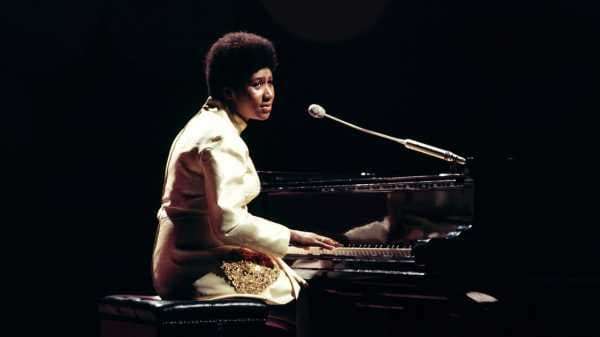
In March of 1971, Aretha Franklin was twenty-eight years old and the undisputed Queen of Soul. She’d had so many gold records over the previous four years that a new category of Grammy had been invented for her. But she was apprehensive about playing for the so-called love crowd at San Francisco’s Fillmore West. Unsure of whether the hippies would dig her, yet determined to break into their market, she prepared several flower-child favorites: songs by the Beatles, Stephen Stills, Simon and Garfunkel. The album “Live at Fillmore West” records her triumph. “All the planets were aligned,” she notes in her memoir, “Aretha: From These Roots,” “because when the music came down, it was as real and righteous as any recording I’d ever made.” Billy Preston, who played organ at the gigs, agreed: “It wasn’t that the hippies just liked her. They went out of their minds . . . [They] flipped the fuck out.”
While Franklin’s covers were characteristically great, her most inspired performance (not included on “Fillmore West” but available on YouTube) was her March 6th rendition of her self-authored blues, “Dr. Feelgood.”
Seated at the piano, where she was always most at home, Franklin starts the song’s slow build. “I don’t want nobody,” she sings, and draws out the next word to painful effect: “ssssssssssssssssittin’ around me and my man . . . ” Her brilliant sense of the erotics of performance meant knowing just how to generate tension, and when to release it. She checks in: “Ain’t that right, girls? Ain’t it right? Yes, it is.”
The recording verges on epic thanks to what follows, which is scandalous and sublimely virtuosic. Describing how “me and my man get to lovin’,” Franklin groans, whoops, sings too fast, and strains so high that her voice cracks. It’s an astonishing, calculated loss of control—such a surprise from a do-right preacher’s daughter. Her simulated orgasm seems to let her fans in on what happens once the “company” leaves. In another show of intimacy, she suggests that they try her good doctor, too: “After one visit to Dr. Feelgood, you’ll understand why Feelgood is his name.” The crowd, singing along with the chorus, becomes a congregation.
The moment gets even better—by ending. The band draws the song to a close, but Franklin isn’t ready to stop, so she ad-libs a call and response: “People, if you understand some of what I say, can I hear you say ‘yeah’?” “Yeah!” This goes on for about a minute while Franklin devises her next moves, which amount to perhaps the most beautiful and unexpected sermonic passages in American popular music:
Sometimes, sometimes I get a little worried, yes, I do
Sometimes . . . I get a little fearful about different things, yes, I
do
But oh! Just as sure as the sun rises in the morning,
I know that everything . . .
If you don’t never do nothing about it, everything’s gonna be alright . . .
Some people, some people worry about whether they gonna wake up in the
morning
Well, why don’t you close your eyes and see? Uh-huh.
Some people worry about if we’re gonna get over this bridge or that
one
And haven’t even got to the bridge yet to see if we can walk across,
oh, yeah . . .
Some people will worry, talking about, “I don’t know what I’m gonna do
if something happens to my child.”
Well, ain’t nothing happened to your child yet. Wait and see.
Will you be able? Wait and see. Will you be able?
Don’t put worry on you before worry gets to you
I said that! Yes, I did.
. . . Oh, you gotta keep your arms around us. You gotta do that for
us, Lord. Yeah, you gotta keep your arms of mercy all around us . . .
Don’t get worried before worry gets there. And everything—oh, you’d be
surprised what big bridges you can meet when you get there.
Ain’t it so? Yes, it is . . .
The passage (of what, in a black religious context, might be called “tuning up”) extravagantly justifies Franklin’s claim that, although she recorded secular music, she never left the Church; she took it with her. But the very structure of this performance, from blues to prayer, makes an additional case: that a woman’s sexual authority need not compromise her spiritual leadership but might actually fuel it. There is apprehension, too. Franklin “gets a little worried” and “fearful” like everyone else. But she knows that “everything’s gonna be alright.” “Don’t put worry on you before worry gets to you”: she repeats the injunction twice, so that what begins as an admonition becomes an assurance of divine clemency, of a force that might take you beyond where you thought you could go—“You’d be surprised what big bridges you can meet when you get there.”
Franklin often said that she didn’t put her politics into her music, but her public support for black radical figures meant that she didn’t have to. She was a tireless fund-raiser for Martin Luther King, Jr., a family friend; in 1970, she offered to post bail for Angela Davis. These social commitments add depth to her music. They allow us to hear in her reference to bridges, for instance, such tortured, bold crossings as that of the Edmund Pettus Bridge by civil-rights activists marching to Selma. They allow us to hear, in her reference to fear for one’s children, a moment when black youth were on the front lines—integrating schools, joining freedom rides, or simply navigating hostile home towns.
This was the promise of soul: that pain granted depth, and that one was never alone but accompanied by a vibrant community that had crossed too many bridges in order to survive. Franklin was the queen not only of soul music but of soul as a concept, because her great subject was the exceeding of limits. Her willingness to extend her own vocal technique, to venture beyond herself, to strain to implausible heights, and revive songs that seemed to be over—all these strategies could look and sound like grace. She knew that we would need it.
Sourse: newyorker.com






